Contents
ABSTRACT
This study utilizes a scientometric/bibliometric analysis to map the status quo of research on finance-growth from 2005 to 2022. By using a sample of 404 articles from the Web of Science Core Collection database and the VOSviewer computer software, the study documented the following: First, research on finance-growth has reached the growth stage with 2021 recording the highest number of publications. Second, business and economics journals have published the largest number of articles. Besides, the USA and China have produced the largest number of articles while Eastern Mediterranean University, Monash University, and Universiti Sains Malaysia are the leading institutions in finance-growth research. Furthermore, Levine Ross, Beck Thorsten, and King Robert can be credited with the modern finance-growth thesis. Finally, economic growth and financial development are the leading keywords in the field.
INTRODUCTION
Financial development is defined as the process of acquiring information at the lowest expenses, implementing agreements, and carrying out activities that foster the development of financial contracts, markets, and mediators.[1] Financial sector development also known as financial system (comprising of financial intermediaries such as banks, financial markets such as bonds and stocks, central banks, payment and settlement systems such as digital payment platforms, and regulatory authorities) plays an essential role in the economic development of a country.[2–4] According to Levine,[3] the financial system influences Economic Growth (EG, henceforth) via the following pathways: First, financial intermediaries such as banks reduce information asymmetry challenges by mobilizing savings from individuals and channeling them into gainful investments. This facilitates employment, capital formation, and innovation leading to EG. Also, efficient financial markets facilitate the trading of financial assets, enabling investors to allocate capital to productive endeavors. This allocation of capital boosts investment, enhances resource allocation, and stimulates economic activity, ultimately leading to increased output and growth. Moreover, an advanced financial system with a robust regulatory system augments corporate governance, transparency, and accountability thereby increasing investor confidence and investment projects output. Furthermore, an established financial system improves openness thereby ensuring the flow of capital. This serves as a hedge against uncertainties and external shocks. Finally, the financial system enables trade by promoting a safe and secure transfer of funds across borders and also improves specialization and labor efficiency.
However, the financial system is often beset with greater costs and risk-taking translating into financial crises.[5,6] A typical example is the 2008 global financial crisis which plummeted the global economy. As a result, several scholars have explored the Finance-Growth (FG, henceforth) linkages to ascertain the intricate interplay between the two variables; however, the empirics remain contradictory. For instance, while Ref.[7–9] discovered that financial development propels EG, Ref.[2,10-14] reached the otherwise. These contrasting findings have also produced four main hypotheses (supply-leading, demand-following, mutual dependence, and neutrality hypotheses) on the FG nexus.
The supply-leading school of thought posits that financial development accelerates EG, primarily by providing savings that can be channeled into productive investments.[3,15-18] Conversely, the demand-following proponents argue that EG itself acts as the catalyst for financial development.[19] They assert that as income expands due to EG, there is an increased demand for additional financial services, thus stimulating further financial development.[3,16] In contrast, the mutual-dependence school of thought emphasizes a reciprocal association between financial development and EG, suggesting that they mutually reinforce each other.[2] Lastly, the neutrality hypothesis suggests that financial development has no direct impact on EG. However, factors such as physical capital, technological advancements, and human capital are the key determinants of EG.[20]
Against these puzzling studies and theories, recent scholars[3,21-24] have deployed systematic reviews to shed more light on the FG relationship. However, as indicated by Levine,[3] the financial system is broad and the FG literature is extensive, thus, to present an extensive overview of the literature, a bibliometric investigation is required. This technique is acknowledged as a novel way of demonstrating the ever-growing breadth of knowledge on a particular subject and it enables researchers to conduct quantitative and qualitative analyses of past literature.[25] Accordingly, the objectives of this study are to (1) examine the fundamental features of the literature, for example, the number of articles and most cited, scrutinize research subjects and illustrious journals; (2) examine the research force, that is, illustrious authors, countries, and institutions (3) recognize the pioneer of this field; (4) reveal the most important keywords; and (5) make recommendations for future studies. By summarizing the recent literature, reviewers, academicians, and policymakers stand to benefit. Also, directions for further studies will be provided, and countries can know much about their research status on FG to help formulate good policies on FG research.
This study contributes to the survey articles on FG by presenting the first bibliometric analysis focusing on a global perspective. Focusing on a global perspective is essential when researching the FG nexus since finance operates in a globally interconnected framework. By utilizing data from the Web of Science Core Collection database and the VOSviewer computer software, we found the following: First, research on FG has reached the growth stage with 2021 recording the highest number of publications. Besides, the USA and China have produced the largest number of articles while Eastern Mediterranean University, Monash University, and Universiti Sains Malaysia are the leading institutions in finance-growth research. Furthermore, Levine Ross, Beck Thorsten, and King Robert can be credited with the modern FG thesis. Finally, EG and financial development are the principal keywords in the field.
The rest of the paper is presented as follows. Section 2 presents the literature review while section 3 presents the methodology. Section 4 presents the results and discussion while section 5 presents the direction for future studies. Finally, the conclusion and managerial implications of the findings are presented in section 6.
Literature review
One of the most studied and debated topics of our time is the FG relationship.[21] Schumpeter[26] was the earliest contributor to the field. He argued that the financial sector spurs EG by boosting technological innovation.[26] King and Levine,[27] and King and Levine[28] provided empirical support to Schumpeter’s[26] assertion, and following their work, there have been mammoth studies on the FG nexus with most of the studies documenting a positive relationship between financial development and EG. For instance, Bist[29] focused on 16 low-income countries spanning 1995 to 2014 and found that financial development spurs EG. Petkovski and Kjosevski[30] documented that the ratio of quasi-money boosts EG for 16 transition countries while private credit and internet margins deprive EG. Focusing on different income groups, Seven and Yetkiner[13] documented that the banking sector development spurs EG for low-income and middle-income countries. A positive effect of financial development on EG has also been documented in Tunisia,[7] Ghana,[8,9] Kenya,[31] China,[32–34] and Saudi Arabia.[11] Other scholars such as Ref.[2,10-14] document either a negative or no relationship between financial development and EG. Some scholars have also documented non-linear linkages between financial development and EG.[35–40] The final group of scholars have explored the causality relationships between financial development and EG with the studies producing conflicting results.[41–45] Table 1 shows a summary of the empirical studies on the FG nexus.
Given the aforementioned conflicting studies, recent scholars have employed systematic reviews to unravel the FG relationship. For instance, Ang[21] provided an extensive overview of FG research. Their work focused on the evolution of financial markets and intermediaries, functions of financial systems, the evolution of the thinking of FG, skepticism of financial development, and models underpinning the FG nexus. Also, a survey article by Popov[22] provided an extensive overview of the FG literature. Furthermore, a survey article by Levine[3] provided an extensive overview of the theories underpinning the FG nexus. Finally, a survey article by Allen et al.[23] and Xu[24] provided an extensive overview of financial structure and EG.
From the literature review, we discovered that no study has employed the bibliometric technique to map the status quo of research on FG. Accordingly, this study is motivated to address this gap. This study; therefore, addresses these important questions: (1) what is the evolutionary trend in this field? (2) what are the influential subject areas in this field? (3) Who are the leading authors in this field? (4) Which authors have the most citations? (5) Which authors can be credited with the FG thesis? (5) Which countries, journals, or institutions lead in this field? (6) What are the leading keywords in this field?
METHODOLOGY
We used bibliometric analysis to map the status quo of FG research. Bibliometric examination portrays the patterns of the research, illustrious authors, publications evolution, illustrious articles, and topics in line with the research question.[46] We used data from the Web of Science Core Collection database. We searched the terms TITLE: (“financial development” OR “financial sector” OR “insurance-growth” OR “stock markets” OR “banks” OR “finance” OR “finance-growth” OR “financial intermediation” OR “banking sector” OR “insurance development” OR “financial liberalisation” OR “financial deepening” OR “bond market” OR “financial system”) AND (“economic growth” OR “economic development” OR “growth”). We collected the data using the title search query because we were interested in the finance growth articles. The title search query gives more tailored articles as compared to the topic search query which encompasses title, abstract, and indexing thereby giving a large number of unrelated articles. The study covered the period from 2005 to 2022 due to data availability. The data was downloaded on 15th July 2022. By using articles and excluding conference papers and unrelated articles, the study extracted 404 articles for the analysis. The data were structured into “author(s)”, “document title”, “year”, “source title”, “citation”, “abstract”, “bibliographical information”, and “volume-issue pages”. The option “full record and cited references” with file format “tab-delimited (Win)” was used to download the data. We used the VOSviewer computer software to conduct the bibliometric analysis. This software shows the visualization patterns in maps. In the VOSviewer, authors with a high number of keywords or articles, or citations receive bigger and bolded circles and vice versa.[47]
| Author(s) | Study Area/Period | Method(s) | Findings |
|---|---|---|---|
| King and Levine[27] | 80 countries [1960-1989] | OLS | Finance raises EG. |
| King and Levine[28] | 77 countries [1960-1989] | OLS | Finance propels EG. |
| Bist[29] | 16 countries [1995-2014] | FMOLSDOLS | Finance promotes EG. |
| Petkovski and Kjosevski[30] | 16 countries [1991-2011] | GMM | The ratio of quasi-money raises EG while private credit and interest margin reduces EG. |
| Ductor and Grechyna[35] | 101 countries [1970-2010] | FD-GMM | Finance boosts EG but the impact depends on the growth of the real and financial sector. |
| Jedidia et al[7] | Tunisia [1973-2008] | ARDL | Private credit increases EG while the stock market does not affect EG. |
| Peprah et al[8] | Ghana [1984-2015] | ARDL | Finance increases EG. |
| Adu et al[9] | Ghana [1961-2010] | ARDL | Private credit increases EG while the stock market does not affect EG. |
| Salah et al[31] | Kenya [1971-2011] | ARDL | Finance boosts EG in the long-run. |
| Samargandi et al[12] | 52 countries [1989-2008] | PARDL | Finance plunges EG in the long run. |
| Samargandi et al[11] | Saudi Arabia [1968-2010] | ARDL | Finance boosts EG in the non-oil sector while the reverse exists in the oil-sector growth. |
| Wahyoe et al[39] | Indonesia [2000-2009] | PARDL | Inverted U-shaped linkages between finance and EG. |
| Seven and Yetkiner[13] | 146 countries [1991-2011] | GMM | Banking sector development boosts low- and middle-income countries’ EG while the contrary exists in high-income countries. |
| Zhang et al[32] | China [2001-2006] | GMM | Finance boosts EG. |
| Chen et al[33] | China [1978-2010] | Panel threshold regression | Finance boosts EG in high-income provinces while low-income provinces have a negative effect. |
| Jalil et al[34] | China [1997-2006] | ARDL | Finance boosts EG. |
| Beck et al[40] | 132 countries [1980-2005] | GMM | There is an inverted U-shaped linkage between finance and EG. |
| Ono[41] | Russia [1999-2014] | Granger causality | EG leads to financial development. |
| Pradhan et al[42] | 17 countries [1991-2012] | Panel VAR | Finance leads to EG. |
| Chu and Chu[36] | 136 countries [1961-2015] | GMM | There is an inverted U-shaped linkage between finance and EG. |
| Hou and Cheng[37] | 31 countries [1981-2008] | PARDL | There is a U-shaped linkage between finance and EG. |
| Hook and Singh[38] | 87 countries [1980-2010] | Panel threshold | There is an inverted U-shaped linkage between finance and EG. |
| Peia and Roszbach[43] | 22 countries | Panel VAR | Stock market causes EG in 11 countries while a reverse causality exists between banking sector development and EG in 16 countries. |
| Balcilar[44] | 10 countries [1995-2016] | Granger causality | Bi-directional causality between finance and EG. |
| Anwar and Sun[10] | Malaysia [1970-2007] | GMM | Finance has an insignificant impact on EG. |
| Appiah-Otoo and Song[2] | Ghana [1990-2014] | ARDL | Finance plunges EG. |
| Swamy and Dharani[14] | 24 countries [1983-2013] | OLS | Finance plunges EG. |
RESULTS AND DISCUSSION
Research trend
Figure 1 shows the trend of FG research over the study period. The result indicates that 2021 recorded the largest number of publications (43 articles representing 10.64%). This was followed by 2020 (37 articles representing 9.16%). Other notable years are 2019 (30 articles representing 7.41%), and 2018 (28 articles representing 6.91%). It was observed that 26 articles representing 6.44% have been published as of 15 July 2022. On average, the FG study has been increasing over the study period. This increasing trend could be attributed to the interest in the topic and the inconsistent findings.
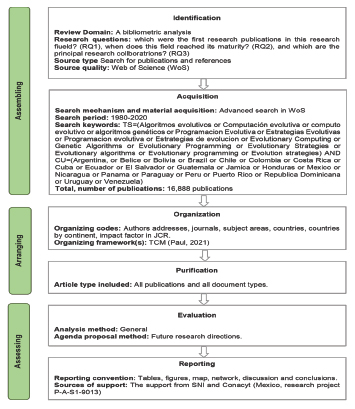
Figure 1:
Trends in finance-growth research from 2005 to 2022. (Source: Authors)

Figure 3:
Country-wise analysis (Source: Authors)
Research areas
Figure 2 shows the top ten research areas in the FG field. The result indicates that Business and Economics journals dominate in this field. Environmental Sciences and Ecology occupy second place. Other leading areas in this field are Development Studies, International Relations, Science and Technology, Mathematical Methods in Social Sciences, Mathematics, Social Sciences, Government and Law, and Public Administration. Business and Economics journals have published 332 articles representing 82.12%. These great feet could emanate from the fact that the finance-growth field falls under the Business and Economics discipline.
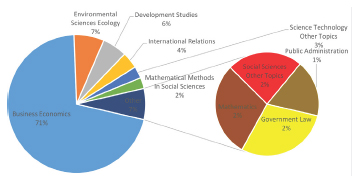
Figure 2:
Research areas
(Source: Authors)
Country-wise, organizations and source analysis
Figure 3 shows the results for the leading countries in the FG studies. The results show that the US and China lead in the FG research (78 articles each). England follows closely with 40 articles. Other important countries are Germany (31), Australia (27), Turkey (26), Italy (25), South Africa (16), and Canada (12). The US and China are the world’s first and second largest economies, thus, their high levels of research output in the FG field. The US has a developed financial system and this could also account for its dominance in this field. Contrary, the financial system in
China remains underdeveloped and it is mostly controlled by the four state-owned banks (Bank of China, the Agricultural Bank of China, the Industrial and Commercial Bank of China, and the China Construction Bank). This might arouse the interest of researchers to gauge the contributions of the financial system to China’s EG.
Figure 4 shows the results for the leading organizations. The result indicates that the Eastern Mediterranean University, Monash University, and Universiti Sains Malaysia are the leaders in FG research (8 articles each representing 1.98%). Other important organizations are; the University of South Africa and Wuhan University (7 articles each representing 1.73%), Brunel University, Federal Reserve System USA, IFO Institut, Vanderbilt University, Universite de Orleans, National Bureau of Economic Research, Indian Institute of Technology System, and IZA Institute Labor Economics have produced 6 articles each representing 1.49%.
Figure 5 shows the leading journals in the FG field. The results show that Applied Economics leads in the FG research (24 articles representing 5.94%). Economic Modelling followed with 15 articles representing 3.71%. Applied Economics Letters 14 articles (3.47%), Emerging Markets Finance and Trade and Journal of Policy Modeling with 11 articles each representing 2.72%, Empirical Economics and International Journal of Finance and Economics have 10 articles each representing (2.48%). Sustainability, Journal of Banking and Finance, African Development Review, Economic Letters, Journal of International Money and Finance, Economic Change and Restructuring, Journal of Macroeconomics, Environmental Science and Pollution Research, and International Review of Economics and Finance are all prominent journals in this field. Except for Environmental Science and Pollution Research, most of the leading journals are in business and economics justifying the findings of Figure 2. Recent scholars such as Tinta,[48] Yue et al.,[49] and Alhassan et al.[50] have examined the role of environmental factors in the FG linkages with Environmental Science and Pollution Research serving as the publication outlet, thus their emergence in the leading publication outlet in this field.
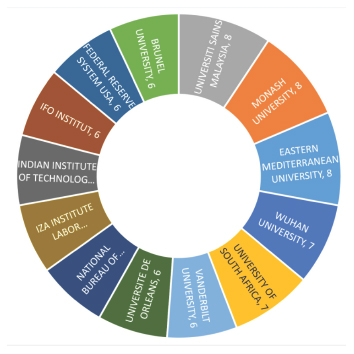
Figure 4:
Organization analysis
(Source: Authors)
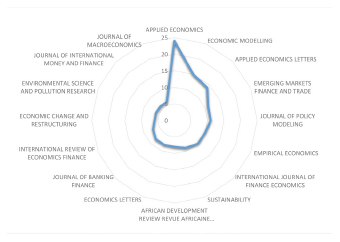
Figure 5:
Sources analysis
(Source: Authors)
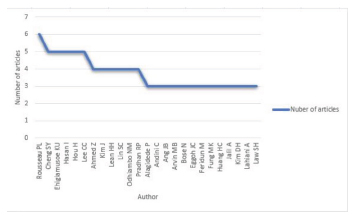
Figure 6:
Author contributions
(Source: Authors)
Author contribution, citations, and text analysis
Figure 6 shows the leading authors in the FG field. The results demonstrate that Rousseau PL leads in the FG research (6 articles representing 1.49%). Cheng SY, Lee CC, Hasani I, Ehigiamusoe KU, and Hou H follow with 5 articles each representing 1.24%. Ahmed Z, Lean HH, Lin SC, Odhiambo NM, Kim J, and Pradhan have 4 articles each representing 0.99%. Alagidede P, Andini C, Ang JB, Arvin MB, Bose N, Eggoh JC, Feridun M, Fung MK, Huang HC, Jalil A, Kim DH, Lahiani A, and Law SH all have 3 articles each representing 0.74%. Rousseau PL has broadened our knowledge of the FG thesis from his initial work “Finance, Investment, and Growth: Time series evidence from 10 Asian economies”. His recent contribution has focused on exploring the moderating role of technological infrastructure and electrification in the FG nexus.[51]
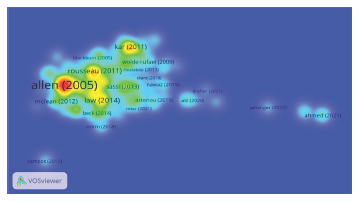
Figure 7:
Author document citation (Source: VOSviewer)

Figure 8:
Author co-citation
(Source: VOSviewer)
Figure 71 shows the density visualization map for the most cited document. The results highlight that Allen et al.[52] is the most cited document followed by Hook and Singh.[38] Other top-cited documents are; Loayza and Rancière,[53] Rousseau and Wachtel,[54] Beck and Levine,[55] Kar et al.,[45] Samargandi et al.,[12] Hasan et al.,[56] Guariglia et al.,[57] McLean et al.,[58] Demetriades and Law,[59] Zhang et al.,[32] Shen and Lee,[60] Liang and Teng,[61] and Fung.[62] Figure 82 present the author’s co-citation analysis. The result shows that Levine R (730), Beck T (489), King RG (304), Rousseau PL (223), Greenwood J (153), Rioja F (148),
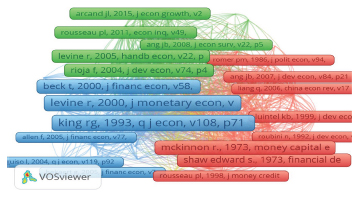
Figure 9:
Co-cited references
(Source: VOSviewer)

Figure 10:
Text analysis
(Source: VOSviewer)
Demir-guc Kunt A (128), Mckinnon RI (125), Rajan Rg (125), and Demetriades PO (124) are the most co-cited authors in the FG field.
Figure 93 present the analysis of co-cited references. The findings suggest that King and Levine,[27] Levine et al.,[15] Mckinnon,[63] Beck et al.,[64] Levine and Zervos,[65] Levine,[66] Greenwood and Jovanovic,[67] Shaw,[68] King and Levine,[28] Demetriades and Hussein,[69] Goldsmith,[70] Lucas,[20] Rajan and Zingales,[71] Rioja and Valev,[72] and Beck and Levine[73] have contributed much to the knowledge base on the FG thesis.
Figure 104 shows the text analysis. The fifteen most important keywords are EG (207), financial development (186), growth (34),
1 We used bibliographic coupling as the type of analysis with documents as the unit of analysis. By selecting 10 as the minimum number of docu¬ments generated 210 thresholds out of the 404 documents. Following Perianes-rodriguez,[75] we used the fractional counting method. The normalization method of association with the visualization scale being documents was also used.
2 We used co-citation as the type of analysis with cited authors as the unit of analysis. By selecting 20 as the minimum number of citations of an author generated 120 thresholds out of 6818 authors. Following Perianes-rodriguez,[75] we used the fractional counting method. The normalization method of association with the visualization scale being documents was also used.
3 We used co-citation as the type of analysis with cited references as the unit of analysis. By selecting 20 as the minimum number of cita¬tions of an author generated 92 thresholds out of the 11041 cited refer¬ences. Following Perianes-rodriguez,[75] we used the fractional counting method. The normalization method of association with the visualization scale being documents was also used.
4 We used co-occurrence as the type of analysis with author keywords as the unit of analysis. By selecting 2 as the minimum number of occur¬rences of a keyword generated 101 thresholds out of 474 keywords. Following Perianes-rodriguez
[
75
]
, we used the fractional counting method. The normalization method of association with the visualization scale being documents was also used.
| Author | Journal | Title | Year | Total citations |
|---|---|---|---|---|
| Allen et al[52] | Journal of FinancialEconomics | Law, finance, and economic growth in China. | 2005 | 1700 |
| Hook and Singh[38] | Journal of Banking and Finance | Does too much finance harm economic growth? | 2014 | 323 |
| Loayza and Rancière[53] | Journal of Money Credit and Banking | Financial development, financial fragility, and growth. | 2006 | 301 |
| Rousseau and Wachtel[54] | Economic Inquiry | What is happening to the impact of financial deepening on economic growth? | 2011 | 262 |
| Beck and Levine[55] | Journal of Money Credit and Banking | Finance, firm size, and growth. | 2008 | 238 |
| Kar et al[45] | Economic Modelling | Financial development and economic growth in the MENA countries: Bootstrap panel granger causality analysis. | 2011 | 222 |
| Samargandi[12] | World Development | Is the relationship between financial development and economic growth monotonic? Evidence from a sample of Middle-Income countries. | 2015 | 217 |
| Hasan et al[56] | Journal of Banking and Finance | Institutional development, financial deepening and economic growth: Evidence from China. | 2009 | 192 |
| Guariglia et al[57] | Journal of Development Economics | Internal finance and growth: Microeconometric evidence on Chinese firms. | 2011 | 186 |
| McLean et al[58] | The Journal of Finance | Why does the law matter? Investor protection and its effects on investment, finance, and growth. | 2012 | 174 |
| Shen and Lee[60] | Journal of Money Credit and Banking | Same financial development yet different economic growth-why? | 2006 | 170 |
| Demetriades andLaw[59] | International Journal of Finance and Economics | Finance, institutions, and economic development. | 2006 | 159 |
| Zhang et al[32] | Journal of Comparative Economics | Financial development and economic growth: Recent evidence from China. | 2012 | 143 |
| Liang and Teng[61] | China Economic Review | Financial development and economic growth: Evidence from China. | 2006 | 141 |
| Fung[62] | Journal of InternationalMoney and Finance | Financial development and economic growth: Convergence or divergence? | 2009 | 132 |
China (15), finance (15), panel data (11), granger causality (11), financial intermediation (10), FG nexus (10), endogenous growth (10), causality (9), economic development (9), sub-Saharan Africa (9), banks (8), and financial markets with 7 occurrences. EG is the leading keyword because policymakers are keen on attaining high and sustainable EG given the merits of growth such as poverty reduction, good health facilities, improved household consumption, and improved human capital development.[74]
Review of the top cited and co-cited documents
Allen et al.[52] studied the associations between law, institutions, finance, and EG in China and found that the legal, and institutional system in China is underdeveloped. They also found that the financial system is underdeveloped with the banking sector ruled and controlled by the four biggest state-owned banks. Loayza and Rancière[53] estimated the influence of financial intermediation on EG for 82 countries from 1960 to 2000. By categorizing countries into financially fragile and financially stable countries, they found that countries with financial volatilities or banking crises tend to have a negative impact of financial intermediation on growth while countries with financial stability have no effect. Beck and Levine[55] extended the FG thesis to the firm level. Using 36 industries from 44 countries for the period 1980 to 1990 found that financial development spurs industrial growth. Rousseau and Wachtel[54] found that financial deepening enhances EG in periods of a stable financial environment. Hook and Singh[38] found that there is a threshold relationship between finance and
| Author | Journal | Title | Year | Co-citations |
|---|---|---|---|---|
| King and Levine[27] | The Quarterly Journal of Economics | Finance and growth: Schumpeter might be right | 1993 | 189 |
| Levine et al[15] | Journal of Monetary Economics | Financial intermediation and growth: Causality and causes | 2000 | 167 |
| Mckinnon[63] | Journal of Development Economics | Money and capital in economic development | 1973 | 120 |
| Beck et al[64] | Journal of FinancialEconomics | Finance and the sources of growth | 2000 | 118 |
| Levine and Zervos[65] | American Economic Review | Stock markets, banks, and economic growth | 1998 | 111 |
| Levine[66] | Journal of Economic Literature | Financial development and economic growth: Views and agenda | 1997 | 110 |
| Greenwood andJovanovic[67] | Journal of PoliticalEconomy | Financial development, growth, and the distribution of income | 1990 | 100 |
| Shaw[68] | Oxford University Press | Financial deepening in economic development | 1973 | 99 |
| King and Levine[28] | Journal of Monetary Economics | Finance, entrepreneurship and growth | 1993 | 95 |
| Demetriades andHussein[69] | Journal of Development Economics | Does financial development cause economic growth? Time-series evidence from 16 countries | 1996 | 94 |
| Goldsmith[70] | New Haven CT: Yale University Press | Financial structure and development | 1969 | 92 |
| Lucas[20] | Journal of Monetary Economics | On the mechanisms of economic growth | 1988 | 90 |
| Rajan and Zingales[71] | American Economic Review | Financial dependence and growth | 1998 | 85 |
| Rioja and Valev[72] | Journal of Development Economics | Does one size fit all? A reexamination of the finance and growth relationship | 2004 | 84 |
| Beck and Levine[73] | Journal of Banking and Finance | Stock markets, banks, and growth: Panel evidence | 2004 | 83 |
EG for 87. Samargandi et al.[12] established that there exists an inverse U-shaped relationship between finance and EG for 52 middle-income countries. Fung[62] reached similar conclusions while using a sample of 57 countries. Kar et al.[45] found no causality between finance and EG for 15 MENA countries.
Shen and Lee[60] found that stock market development drives EG while banking development hurts EG for 48 countries. They further found that the negative effect of banking development disappears given good shareholder protection, high income, and financial liberalization. Conversely, they found that the negative effect of banking development worsens given high corruption, banking and currency crises, middle-income levels, African and Latin American dummies, and better creditor protection. Demetriades and Law[59] also found that financial development has a greater positive impact in countries with developed institutional quality as compared to countries with weak institutional quality. McLean et al.[58] also concluded that countries with advanced investor protection tend to have a higher growth impact from financial development and vice versa. Focusing on China, Hasan et al.[56] found that capital market development spurs EG while bank lending impedes EG. Turning to the city level, Zhang et al.[32] found that financial development induces city-level EG in China. Liang and Teng[61] estimated the causality relationships between financial development and EG in China and found a unidirectional causality from EG to financial development. Guariglia et al.[57] extended the FG nexus to the firm level in China. Using 79,841 firms for 31 provinces from 2000 to 2007 found that cash flows do not affect collective firms and State-Owned Enterprises’ assets while foreign-owned firms and private firms are affected.
King and Levine[27] estimated the FG links for 80 countries and found that financial development spurs EG. This was supported by Levine et al.,[15] Levine and Zervos,[65] Beck et al.,[64] Rajan and Zingales,[71] Beck and Levine,[73] Rioja and Valev,[72] and King and Levine.[28] Conversely, Demetriades and Hussein[69] found a feedback relationship between FG. In this regard, Levine[66] provided an extensive survey of the FG literature. Mckinnon,[63] Goldsmith,[70] and Shaw[68] provided the theoretical basis of the FG links. Table 2 shows a summary of the top fifteen cited documents. Table 3 shows a summary of the top fifteen co-cited documents.
Direction for future studies
Building on the network nodes and links of Figure 10. we make these recommendations for future studies. Firstly, future studies should examine the moderating role of inflation in the stock market-growth nexus. Secondly, future studies should examine the impact of financial intermediation on investment in China and Malaysia. Also, future studies should examine the nexus between the stock market, banks, and EG in transition economies. Besides, future studies should explore the moderating role of foreign direct investment in the FG nexus. Moreover, future studies should examine the causal nexus between life and non-life insurance penetration and EG in emerging countries. In addition, future studies should examine the impact of financial innovation on EG. Furthermore, future studies should explore the linkages between human capital, financial development, and EG in India. Finally, future studies should examine the moderating role of research and development in the FG thesis.
CONCLUSION
The FG empirics abound; nevertheless, the empirical findings remain contradictory. Recent scholars have adopted systematic literature reviews to gauge the FG connection. This study differed from the previous studies by conducting bibliometric analysis. Specifically, the study sought to understand the trend of the FG nexus, leading subject areas, leading and most cited authors, leading countries, journals, or institutions, and keywords. The study found the following: First, research on FG has reached the growth stage with 2021 recording the highest number of publications. Second, business and economics journals have published the largest number of articles. Besides, the USA and China have produced the largest number of articles while Eastern Mediterranean University, Monash University, and Universiti Sains Malaysia are the leading institutions in FG research. Furthermore, Levine Ross, Beck Thorsten, and King Robert can be credited with the modern FG thesis. Finally, EG, financial development, growth, China, finance, panel data, granger causality, financial intermediation, FG nexus, endogenous growth, causality, economic development, sub-Saharan Africa, banks, and financial markets are the leading keywords in the field.
From the qualitative perspective, the study showed that Allen et al.’s[52] work “Law, finance and economic growth in China” made the most contribution in this field with 1700 citations. Also, King and Levine’s[27] work “Finance and growth: Schumpeter might be right” was the most co-cited document in this field with 189 co-citations.
The implications of these findings are as follows. First, this study highlights the productivity of each country, author, institution, and journal in this field. This revelation can help policymakers, governments, and academicians better comprehend and appreciate each country, author, institution, and journal’s role in this field. Also, highlighting the leading countries in this field show the relevance of this topic to a particular country. This will motivate further studies to concentrate on these countries while efforts will also be made to promote this field in the less studied countries. Besides, the study has presented several directions for future research based on the leading keywords and network analysis. This can spur further research in this field. In addition, the study shows that business and economics journals dominate this field accordingly further efforts can be made to promote this field in other less-knowledge domains such as mathematics and public administration. Moreover, the findings of this study highlight the relevance of the financial sector to EG, thus policymakers should continuously promote the financial sector. This will ensure the efficient utilization of resources. Furthermore, policymakers should adopt policies that will ensure the timely and full repayment of loans. This will help reduce the problem of non-performing loans and ensure financial stability. Finally, policymakers should promote effective regulations and bank supervision to reduce too much liquidity to help control inflation. This study is not without some weaknesses. First, this study focused only on the FG relationship while ignoring other less know areas like sustainability, carbon neutrality, and cleaner production. Accordingly, future studies can consider these areas. Second, this study started from 2005 due to the unavailability of data beyond 2005 from the Web of Science Core Collection database at the time the data was downloaded. Notwithstanding these limitations, this study has presented the first bibliometric analysis of the FG thesis with the empirical results being consistent, undisputable, and grounded on unbiased data.
Cite this article
Appiah-Otoo I. A Bibliometric Assessment of the Finance-growth Literature: Current Status, Development and Future Direction. J Scientometric Res. 2023;12(2):321-31.
ACKNOWLEDGEMENT
We are very grateful to the Editor Prof. Sujit Bhattacharya and the two anonymous reviewers of this journal whose constructive comments helped improve the quality and readability of this manuscript.
References
- Akinlo T, Yinusa DO, Adejumo AV. Financial development and real sector in sub-Saharan Africa. 2020 Available from: [CrossRef]
- Appiah-Otoo I, Song N. Finance-growth nexus:New insight from Ghana. International Journal of Finance and Economics. 2022;27(3):2682-723. [CrossRef] | [Google Scholar]
- Levine R. Chapter 12 Finance and Growth:Theory and evidence. Handbook of Economic Growth. 2005;1(Suppl Part A):865-934. [CrossRef] | [Google Scholar]
- Xu G, Gui B. The non-linearity between finance and economic growth:a literature review and evidence from China. Asian-Pacific Economic Literature. 2021;35(1):3-18. [CrossRef] | [Google Scholar]
- Chen R, Yu J, Jin C, Bao W. Internet finance investor sentiment and return comovement. Pacific-Basin Finance Journal. 2019;56:151-61. [CrossRef] | [Google Scholar]
- Song N, Appiah-Otoo I. The Impact of Fintech on Economic Growth:Evidence from China. Sustainability. 2022;14(10):6211 Available from:https://www.mdpi.com/2071-1050/14/10/6211/htm
[CrossRef] | [Google Scholar] - Ben Jedidia K, Boujelbène T, Helali K. Financial development and economic growth:New evidence from Tunisia. Journal of Policy Modeling. 2014;36(5):883-98. [CrossRef] | [Google Scholar]
- Peprah JA, Ofori I, Asomani AN. Financial development, remittances and economic growth:A threshold analysis. Cogent Economics and Finance. 2019;7(1) [CrossRef] | [Google Scholar]
- Adu G, Marbuah G, Mensah JT. Financial development and economic growth in Ghana:does the measure of financial development matter?. Review of Development Finance. 2013;3(4):192-203. [CrossRef] | [Google Scholar]
- Anwar S, Sun S. Financial development, foreign investment and economic growth in Malaysia. Journal of Asian Economics. 2011;22(4):335-42. [CrossRef] | [Google Scholar]
- Samargandi N, Fidrmuc J, Ghosh S. Financial development and economic growth in an oil-rich economy:The case of Saudi Arabia. Economic Modelling. 2014;43:267-78. [CrossRef] | [Google Scholar]
- Samargandi N, Fidrmuc J, Ghosh S. Is the Relationship Between Financial Development and Economic Growth Monotonic ? Evidence from a Sample of Middle-Income Countries. World Development. 2015;68:66-81. [CrossRef] | [Google Scholar]
- Seven Ü, Yetkiner H. Financial intermediation and economic growth:Does income matter?. Economic Systems. 2016;40(1):39-58. [CrossRef] | [Google Scholar]
- Swamy V, Dharani M. An alternate approach in exploring the causal link between financial development and economic growth — Evidence from advanced economies. International Journal of Finanance and Economics. 2018;23(1):55-76. [CrossRef] | [Google Scholar]
- Levine R, Loayza N, Beck T. Financial intermediation and growth:Causality and causes. Journal of Monetary Economics. 2000;46:31-7. [CrossRef] | [Google Scholar]
- Kassim S. Islamic finance and economic growth:The Malaysian experience. Global Finance Journal. 2016;30:66-76. [CrossRef] | [Google Scholar]
- . Financial deepening in economic development. Journal of Development Economics. Array;1(1):Array-4. Available from:https://www.sciencedirect.com/science/article/pii/0304387874900248
[CrossRef] | [Google Scholar] - . Money and capital in economic development. World Development. Array;2(3):Array-8. Available from:https://www.sciencedirect.com/science/article/pii/0305750X74900989
[CrossRef] | [Google Scholar] - Robinson J. The rate of interest and other essays. 1952 [CrossRef] | [Google Scholar]
- Lucas RE. Journal of Monetary Economics. 1988;22:3-42. Available from:http://linkinghub.elsevier.com/retrieve/pii/0304393288901687
On the mechanics of economic development. - Ang JB. A survey of recent developments in the literature of finance and growth. Journal of Economic Surveys. 2008;22(3):536-76. [CrossRef] | [Google Scholar]
- Popov A. Evidence on finance and economic growth. Handbook of Finance and Development. 2018(2115):63-104. [CrossRef] | [Google Scholar]
- Allen F, Gu X, Kowalewski O. Financial structure, economic growth and development. Handbook of Finance and Development. 2018:31-62. [CrossRef] | [Google Scholar]
- Xu G. Reassessing the Literature on the Relationship between Financial Structure and Economic Growth. Review of Economics. 2021;72(2):149-82. [CrossRef] | [Google Scholar]
- Aboagye EM, Zeng C, Owusu G, Mensah F, Afrane S, Ampah JD, et al. A review contribution to emission trading schemes and low carbon growth. Environmental Science and Pollution Research. 2023 [CrossRef] | [Google Scholar]
- Schumpeter J. Theorie der wirtschaftlichen Entwicklung. Theorie der wirtschaftlichen Entwicklung. 1911:5-6. [CrossRef] | [Google Scholar]
- King RG, Levine R. Finance and growth:Schumpeter might be right. The Quarterly Journal of Economics. 1993;108(3):717-37. [CrossRef] | [Google Scholar]
- King RG, Levine R. Finance, entrepreneurship, and growth Theory and evidence. Journral of Monetary Economics. 1993;32(May):513-42. [CrossRef] | [Google Scholar]
- Bist JP. Financial development and economic growth:Evidence from a panel of 16 African and non-African low-income countries. Cogent Economics and Finance. 2018;6(1) [CrossRef] | [Google Scholar]
- Petkovski M, Kjosevski J. Does banking sector development promote economic growth? An empirical analysis for selected countries in central and south eastern europe. Economic Research-Ekonomska Istrazivanja. 2014;27(1):55-66. [CrossRef] | [Google Scholar]
- Salah G, Sjö B, Shahbaz M. The causal nexus between financial development and economic growth in Kenya. Economic Modelling. 2013;35:701-7. [CrossRef] | [Google Scholar]
- Zhang J, Wang L, Wang S. Financial development and economic growth:Recent evidence from China. Journal of Comparative Economics. 2012;40(3):393-412. [CrossRef] | [Google Scholar]
- Chen KC, Wu L, Wen J. The relationship between finance and growth in China. Global Finance Journal. 2013;24(1):1-12. [CrossRef] | [Google Scholar]
- Jalil A, Feridun M, Ma Y. Finance-growth nexus in China revisited:new evidence from principal components and ARDL bounds tests. International Review of Economics and Finance. 2010;19(2):189-95. [CrossRef] | [Google Scholar]
- Ductor L, Grechyna D. Financial development, real sector, and economic growth. International Review of Economics and Finance. 2015 [CrossRef] | [Google Scholar]
- Chu LK, Chu HV. Is too much liquidity harmful to economic growth?. The Quartely Review of Economics and Finance. 2019 [CrossRef] | [Google Scholar]
- Hou H, Cheng SY. The dynamic effects of banking, life insurance, and stock markets on economic growth. Japan and the World Economy. 2017;41:87-98. [CrossRef] | [Google Scholar]
- Hook S, Singh N. Does too much finance harm economic growth ?. Journal of Banking and Finance. 2014;41:36-44. [CrossRef] | [Google Scholar]
- Wahyoe S, Iftekhar H, Nuruzzaman A. Non-linearity in the finance-growth nexus:evidence from Indonesia. International Economics. 2017;150:19-35. [CrossRef] | [Google Scholar]
- Beck R, Georgiadis G, Straub R. The finance and growth nexus revisited. Economics Letters. 2014;124(3):382-5. [CrossRef] | [Google Scholar]
- Ono S. Financial development and economic growth nexus in Russia. Russian Journal of Economics. 2017;3(3):321-32. [CrossRef] | [Google Scholar]
- Pradhan RP, Arvin MB, Bahmani S, Hall JH, Norman NR. Finance and growth:Evidence from the ARF countries. The Quarterly Review of Economics and Finance. 2017;66:136-48. [CrossRef] | [Google Scholar]
- Peia O, Roszbach K. Finance and growth:time series evidence on causality. Journal of Financial Stability. 2015;19:105-18. [CrossRef] | [Google Scholar]
- Balcilar M, Gupta R, Lee CC, Olasehinde-Williams G. The synergistic effect of insurance and banking sector activities on economic growth in Africa. Economic Systems. 2018;42(4):637-48. [CrossRef] | [Google Scholar]
- Kar M, Nazlioğlu Ş, Ağir H. Financial development and economic growth nexus in the MENA countries:Bootstrap panel granger causality analysis. Economic Modelling. 2011;28(1–2):685-93. [CrossRef] | [Google Scholar]
- Milian EZ, Spinola M, de M, Carvalho MM d. Fintechs:A literature review and research agenda. Electronic Commerce Research and Applications. 2019;34 [CrossRef] | [Google Scholar]
- van Eck NJ, Waltman L. Software survey:VOSviewer, a computer program for bibliometric mapping. Scientometrics. 2010;84(2):523-38. [CrossRef] | [Google Scholar]
- Tinta AA. Financial development, ecological transition, and economic growth in Sub-Saharan African countries:the performing role of the quality of institutions and human capital. Environmental Science and Pollutution Research. 2022;29(25):37617-32. [CrossRef] | [Google Scholar]
- Yue S, Lu R, Chen H, Yuan J. Does financial development promote the win-win balance between environmental protection and economic growth?. Environmental Science and Pollution Research. 2018;25(36):36438-48. Available from:https://link.springer.com/article/10.1007/s11356-018-3549-y
[CrossRef] | [Google Scholar] - Alhassan H, Kwakwa PA, Donkoh SA. The interrelationships among financial development, economic growth and environmental sustainability:evidence from Ghana. Environmental Science and Pollution Research. 2022;29(24):37057-70. [CrossRef] | [Google Scholar]
- Cotter C, Rousseau PL, Vu NT. Electrification, telecommunications, and the finance-growth nexus:Evidence from firm-level data. Energy Economics. 2021;94:105073 [CrossRef] | [Google Scholar]
- Allen F, Qian J, Qian M. Law , finance , and economic growth in China. Journal of Financial Economics. 2005;77:57-116. [CrossRef] | [Google Scholar]
- Loayza N V, Rancière R. Financial Development, Financial Fragility, and Growth. Journal of Money, Credit and Banking. 2013;38(4):1051-76. [CrossRef] | [Google Scholar]
- Rousseau PL, Wachtel P. What is happening to the impact of financial deepening on economic growth?. Economic Inquiry. 2011;49(1):276-88. [CrossRef] | [Google Scholar]
- Beck T, Levine R. Finance, Firm Size, and Growth. Journal of Money, Credit, and Banking. 2008;40(7) [CrossRef] | [Google Scholar]
- Hasan I, Wachtel P, Zhou M. Institutional development , financial deepening and economic growth:Evidence from China. Journal of Banking & Finance. 2009;33(1):157-70. [CrossRef] | [Google Scholar]
- Guariglia A, Liu X, Song L. Internal finance and growth:Microeconometric evidence on Chinese firms. Journal of Development Economics. 2011;96:79-94. [CrossRef] | [Google Scholar]
- McLean RD, Zhang T, Zhao M. Why Does the Law Matter? Investor Protection and Its Effects on Investment, Finance, and Growth. The Journal of Finance. 2012;67(1):313-50. [CrossRef] | [Google Scholar]
- Demetriades P, Law SH. Finance, institutions and economic development. International Journal of Finance & Economics. 2006;11(3):245-60. [CrossRef] | [Google Scholar]
- Shen C hua, Lee C chiang. Same financial development yet different economic growth-why ?. Journal of Money, Credit and Banking. 2015;38(7):1907-44. [CrossRef] | [Google Scholar]
- Liang Q, Teng J zhou. Financial development and economic growth:Evidence from China. China Economic Review. 2006;17:395-411. [CrossRef] | [Google Scholar]
- Fung MK. Financial development and economic growth:Convergence or divergence ?. Journal of International Money and Finance. 2009;28(1):56-67. [CrossRef] | [Google Scholar]
- Mckinnon RI. Money and capital in economic development. Journal of Development Economics. 1973;1(4):81-4. [CrossRef] | [Google Scholar]
- Beck T, Levine R, Loayza N. Finance and the sources of growth. Journal of Financial Economics. 2000;58:261-300. [CrossRef] | [Google Scholar]
- Levine R, Zervos S. Stock markets, banks, and economic growth. American Economic Review. 1998;88(3):537-58. [CrossRef] | [Google Scholar]
- Levine R. Financial development and economic growth:Views and agenda. Journal of Economic Literature. 1997;35(2):688-726. [CrossRef] | [Google Scholar]
- Greenwood J, Jovanovic B. Financial development, growth, and the distribution of income. Journal of Political Economy. 1990;98(5, Part 1):1076-107. [CrossRef] | [Google Scholar]
- Shaw ES. Financial deepening in economic development. 1973:xii [CrossRef] | [Google Scholar]
- Demetriades PO, Hussein KA. Does financial development cause economic growth? Time-series evidence from 16 countries. Journal of Development Economics. 1996;51(2):387-411. [CrossRef] | [Google Scholar]
- Goldsmith RW. Financial structure and development. 1969:114-23. Available from:http://www.nber.org/chapters/c4417.pdf
[CrossRef] | [Google Scholar] - Rajan RG, Zingales L. Financial Dependence and Growth. American Economic Review. 1998;88(3):559-86. [CrossRef] | [Google Scholar]
- Rioja F, Valev N. Does one size fit all?:a reexamination of the finance and growth relationship. Journal of Deveopment Economics. 2004;74(2):429-47. [CrossRef] | [Google Scholar]
- Beck T, Levine R. Stock markets, banks, and growth:Panel evidence. Journal of Banking & Finance. 2004;28(3):423-42. [CrossRef] | [Google Scholar]
- Appiah-Otoo I, Acheampong AO, Song N, Obeng CK, Appiah IK. Foreign aid— Economic Growth Nexus in Africa:Does Financial Development Matter?. International Economic Journal. 2022;36(3):418-44. [CrossRef] | [Google Scholar]
- Perianes-rodriguez A, Waltman L, Jan N, Eck V. Constructing bibliometric networks:A comparison between full and fractional counting. Journal of Informetrics. 2016;10(4):1178-95. [CrossRef] | [Google Scholar]

